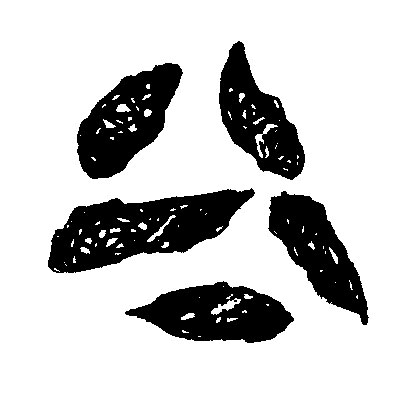All About Mouse Poop!
By Chris Williams on October 14, 2014.

Mouse droppings are “spindle-shaped,” or widest in the middle and tapering to a point.

If you’ve dealt with a mouse infestation before, you probably already know what mouse poop looks like. But if mouse problems are new to you, it’s important to know what to look for.
In the pest control industry, we generally call mouse poop, “droppings.” Of course, it’s technically feces or the bowel movements of a defecating mouse. Unlike most other mammals, a mouse doesn’t just defecate once a day, or even twice, or even thirty times a day. Try 70! A single mouse can leave 70 droppings a day, a few at a time, in lots of different places.
What Does Mouse Poop Look Like?
Mouse droppings are usually black and have sometimes been described as “spindle-shaped,” meaning they are widest in the middle and taper to almost a point, at least on one end. In contrast, a rat’s dropping is more rectangular in shape and blunt at the ends. Each dropping from a full-grown mouse is about ¼ inch long, compared to a rat’s dropping which is ¾ inch long.
If you look at a few droppings under magnification, you will probably find they contain mouse hairs from grooming. That’s one way we distinguish them from the similar feces of crickets or large cockroaches. And if you find droppings that are green, blue, or pink instead of black, that means that the mice have been feeding on dyed rodent bait.
Is It Old Poop or New Poop, and Who Cares?
Determining the age of the droppings can tell you whether or not the mouse infestation is still active. Fresh droppings are black or nearly black, glistening and wet-looking, with the consistency of putty when pressed (use a pencil). They’re soft enough to be pressed out of shape.
Fresh droppings indicate that the mouse infestation is active and ongoing. Finding fresh droppings of a couple of sizes could mean that you have a breeding population of both older and young mice…not good news. You can do what exterminators do—sweep up all the droppings that you find and wait to see if new ones appear. That’s a simple way to find out if mice are still present.
Mouse droppings start to become hard several hours after they are deposited (but in a really damp area, they may stay soft for some time). The surface eventually becomes dry and dull-looking. Old droppings are grayish, dusty-looking, and crumble easily when pressed. Very old droppings, especially in a damp area, will often be moldy.
Where Do You Find Mouse Poop?
Mice leave droppings wherever they go. They even poop as they move along their travel routes; heavily used runways will have droppings scattered along their entire length. The highest numbers of droppings will be found near where the mice nest (but not in the nest) or where they feed.
For tips on where to look for mouse nests, see Where Do Mice Nest? and Could This Be a Mouse Nest?
Droppings are only one of the signs that mice are present. For the others, see Telltale Signs of Mice.
 Want to learn more about mice & rats?
Want to learn more about mice & rats?
Download our free e-book Identifying and Removing Mice & Rats From Your Home!